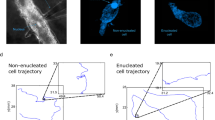Summary
The movement of slime-mold amoebae under isotropic conditions in two dimensions is represented as a Correlated Walk with straight steps of variable length. The steps are correlated via the angle α turned through from step to step. The hypotheses and predictions of the model compare favourably with experimental data for Dictyostelium discoideum amoebae.
Similar content being viewed by others
References
Adler, J.: The sensing of chemicals by bacteria. Sc. Am. 234, No. 4, 40–47 (1976).
Barber, M. N., Ninham, B. W.: Random and restricted walks. New York: Gordon and Breach 1970.
Berg, H. C., Brown, D. A.: Chemotaxis in Escherichia coli analysed by three-dimensional tracking. Nature 239, 500–504 (1972).
Berg, H. C.: How bacteria swim, Sc. Am. 233, No. 2, 36–44 (1975).
Feller, W.: An introduction to probability theory and its applications II. New York: J. Wiley 1966.
Fürth, von R..: Die Brownsche Bewegung bei Berücksichtigung einer Persistenz der Bewegungs-richtung. Mit Anwendungen auf die Bewegung lebender Infusorien. Zeit. f. Phys. II, 244–256 (1920).
Gail, M. H., Boone, C. W.: The locomotion of mouse fibroblasts in tissue culture. Biophys. J. 10, 980–993 (1970).
Hájek, J.: Non-parametric Statistics. San Francisco: Holden-Day 1968.
Klein, G.: A generalization of the classical random-walk problem and a simple model of Brownian motion based thereon. Proc. R. Soc. Ed. 63, 268–279 (1952).
Lovely, P. S., Dahlquist, F. W.: Statistical measures of bacterial motility and chemotaxis. J. Theor. Biol. 50, 477–496 (1975).
Noble, P. B.; Peterson, S. C.: A two-dimensional random walk analysis of aggregating sponge cells prior to cell contact. Expt. Cell Res. 75, 288–290 (1972).
Nossal, R. J., Weiss, G. H.: A generalized Pearson random walk allowing for bias. J. Stat. Phys. 3, 245–253 (1974a).
Nossal, R. J., Weiss, G. H.: A descriptive theory of cell migration on surfaces. J. Theor. Biol. 47, 103–113 (1974b).
Patlak, C. S.: Random walk with persistence and external bias. Bull. Math. Biophys. 15, 311–338 (1953).
Peterson, S. C., Noble, P. B.: A two-dimensional random-walk analysis of human granulocyte movement. Biophys. J. 12, 1048–1055 (1972).
Ramsey, W. S., Harris, A.: Leucocyte locomotion and its inhibition by antimitotic drugs. Expt. Cell Res. 82, 262–270 (1972).
Tchen, C. M.: Random flight with multiple partial correlations. J. Chem. Phys. 20, 214–217 (1950).
Author information
Authors and Affiliations
Additional information
This work was supported in part by an M. R. C. Grant # MA 5340.
Rights and permissions
About this article
Cite this article
Hall, R.L. Amoeboid movement as a correlated walk. J. Math. Biol. 4, 327–335 (1977). https://doi.org/10.1007/BF00275081
Received:
Revised:
Issue Date:
DOI: https://doi.org/10.1007/BF00275081




